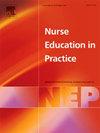Leadership competences in undergraduate nurse education: Scale development and model testing
IF 3.3
3区 医学
Q1 NURSING
引用次数: 0
Abstract
Aim
To develop and psychometrically validate a scale based on the Healthcare Leadership Model among undergraduate nursing students.
Background
Effective leadership by nurses at the point of care delivery is essential for high quality, safe and effective care. At the same time, leadership at all levels is important to ensure appropriate staffing workforce planning and service improvement. Despite the importance of leadership, undergraduate nursing students often feel under-prepared for their leadership role as newly qualified nurses. While a variety of leadership tools have been developed to enable students to self-assess none of these tools relate to multi-level leadership.
Design
A scale development and validation study employing a cross-sectional design.
Methods
Preliminary analysis ensured multivariate normality. Psychometric analyses tested the scale’s reliability (Cronbach’s Alpha) and validity by performing an Exploratory Factor Analysis with a direct oblimin rotation. A Confirmatory Factor Analysis compared the empirical model developed in this study and the theoretical one.
Results
289 final-year undergraduate nursing students were included in the final sample. The results suggest that the scale is appropriate to assess nursing students’ leadership competences. Exploratory factor analysis indicates the model has 6 factors rather than the 9 dimensions outlined in the theoretical model.
Conclusion
The notion of leadership at all levels to ensure safe, high quality and effective care is now well embedded globally. This study demonstrates that the Healthcare Leadership Model can be adapted and effectively adopted as a framework for leadership development amongst undergraduate nursing students.
本科护士教育的领导能力:量表开发与模型检验
目的编制基于护理本科生医疗领导模型的量表,并对其进行心理计量学验证。背景护士在提供护理时的有效领导对高质量、安全和有效的护理至关重要。与此同时,各级领导对于确保适当的人员配备、劳动力规划和服务改进也很重要。尽管领导力很重要,本科护理专业的学生经常觉得自己作为新合格护士的领导角色准备不足。虽然已经开发了各种各样的领导力工具,使学生能够自我评估,但这些工具都与多层次领导力无关。设计采用横断面设计的规模开发和验证研究。方法进行初步分析,确保多元正态性。心理测量分析测试了量表的信度(Cronbach 's Alpha)和效度,通过执行探索性因素分析与直接模糊旋转。验证性因子分析比较了本研究的实证模型和理论模型。结果最终样本包括289名护理本科毕业班学生。结果表明,该量表适用于评价护生领导能力。探索性因素分析表明,该模型有6个因素,而不是理论模型中概述的9个维度。结论各级领导确保安全、优质、有效护理的理念已在全球深入人心。本研究表明,医疗保健领导力模型可以作为护理本科学生领导力发展的框架进行调整和有效采用。
本文章由计算机程序翻译,如有差异,请以英文原文为准。
求助全文
约1分钟内获得全文
求助全文
来源期刊

Nurse Education in Practice
NURSING-
CiteScore
5.40
自引率
9.40%
发文量
180
审稿时长
51 days
期刊介绍:
Nurse Education in Practice enables lecturers and practitioners to both share and disseminate evidence that demonstrates the actual practice of education as it is experienced in the realities of their respective work environments. It is supportive of new authors and will be at the forefront in publishing individual and collaborative papers that demonstrate the link between education and practice.
 求助内容:
求助内容: 应助结果提醒方式:
应助结果提醒方式:


